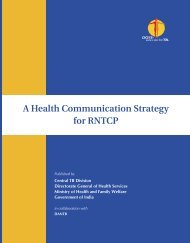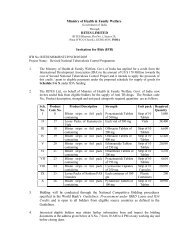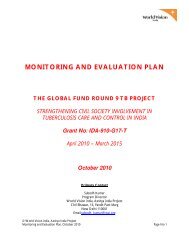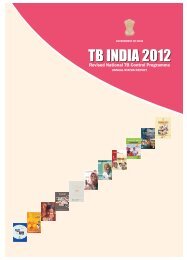National PMDT Scale-up Plan - India - 2011-12 - TBC India
National PMDT Scale-up Plan - India - 2011-12 - TBC India
National PMDT Scale-up Plan - India - 2011-12 - TBC India
You also want an ePaper? Increase the reach of your titles
YUMPU automatically turns print PDFs into web optimized ePapers that Google loves.
1. Introduction<br />
<strong>National</strong> <strong>Scale</strong> <strong>up</strong> <strong>Plan</strong> for Programmatic Management of DR TB <strong>2011</strong> - 20<strong>12</strong><br />
<strong>India</strong> has one-fifth of the world’s MDR TB burden. WHO has estimated that 99,000 MDR-TB cases<br />
emerging in <strong>India</strong> in 2008 – the largest number for any country globally after China. Drug resistant TB<br />
has frequently been encountered in <strong>India</strong> and its presence has been known virtually from the time first<br />
line anti-tuberculosis drugs were introduced for the treatment of TB. There have been a number of<br />
reports on drug resistance in <strong>India</strong>, but the studies used non-standardized methodologies and biased<br />
samples, usually from tertiary level care facilities. There is, however, some valid district and state level<br />
information about extent of drug resistance available.<br />
In 2005-06, RNTCP had undertaken state-representative drug resistance surveys in 3 states, which are<br />
conducted according to a standard international protocol, and collect specimens from a populationbased<br />
sample of smear-positive patients diagnosed at RNTCP designated microscopy centers; the<br />
findings are summarized in the table below:<br />
Table 1: State Representative Drug Resistance Surveillance Surveys conducted in <strong>India</strong><br />
State (Survey year) Population<br />
MDR among new cases<br />
(95% CI)<br />
8<br />
MDR among previously-<br />
Rx cases (95% CI)<br />
Gujarat (2007-08) 56 million 2.4% 17.4%<br />
Maharashtra (2008) 108 million 2.7% 14.0%<br />
Andhra Pradesh (’09) 86 million 1.8% 11.8%<br />
DRS surveys are on-going in the state of Orissa and the western half of Uttar Pradesh state. The results<br />
from these surveys are expected in early 2010. Additional drug resistance surveys are planned in <strong>2011</strong>-<br />
<strong>12</strong> in Tamil Nadu (a second State survey) after 10 years) and Rajasthan. Surveys are planned to be<br />
repeated after a gap of 5 years from the initial survey to observe the trends in DR-TB.<br />
<strong>India</strong> has also reported cases of extensively drug-resistant TB (XDR-TB) to WHO. The state representative<br />
drug-resistance survey of Gujarat state showed, among MDR TB isolates, 3.2% (confidence limits) XDR<br />
prevalence, but also showed a very high prevalence of fluoroquinolone resistance (%); a credible<br />
estimate of the number of fluroquinolone-resistant or XDR-TB cases in the country is not available.<br />
A national level RNTCP DOTS-Plus Committee was established in April 2005, to develop the national<br />
guidelines (policies and procedures) for the programmatic management of drug-resistant tuberculosis<br />
(<strong>PMDT</strong>) and also suggest periodic modification in the same in light of the current scientific evidence.<br />
The RNTCP <strong>PMDT</strong> Guidelines (called “DOTS-Plus” guidelines) were first published in March 2006 and are<br />
<strong>up</strong>dated regularly with the latest issued in May 2010. Procurement mechanism for second-line drugs,<br />
including technical specifications, systems for storage, distribution and quality assurance of the drugs,<br />
etc. were developed. Procurement of the required drugs is conducted by the GoI and also by the Global






